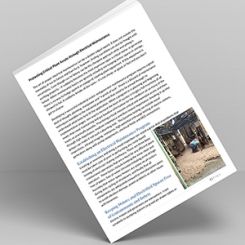Sewage pumps operate based on Daniel Bernoulli’s principles (Hydrodynamica, 1738), which define the effects of balanced energy on fluid systems. This equation employs kinetic pressure and potential energies that are required to move a matrix of solids and water through a conduit with specific properties. This movement must maintain a minimum velocity of 2 feet (61 centimeters) per second to prevent the buildup of solid scaling on the walls of the piping conduit Contrary to popular belief, pumps do not create pressure. Pumps create flow, and restricting this flow, either within the confines of a pump or the boundaries of a pipe, results in pressure. As the areas that maintain the flow are changed through orifice sizes, clearances between parts and pipe diameters and lengths, the pressure, and flow rate reflect those changes. Two types of sewage pumps are ejector/solids-handling pumps and grinder pumps. Ejector/solids-handling pumps use different mechanical and electrical methods to deliver wastewater and solids from one location to another. Different motors and impellers are used to develop flows, and different pump housings allow for the passage of different solid sizes. Impeller types include vortex, semi-open, closed, multi-vane and single vane. The impeller is attached to the motor shaft and operates at different speeds, ranging from 600 to 3,450 rpm. The pump’s speed depends on the motor. Variable frequency drives are also used to control motor speeds. The motor operates the impeller, which provides energy to the liquid creating the flow and a vortex inside the pump housing. Centrifugal forces created by the impeller on the water deepen the vortex. The water and suspended solids are compressed against the walls of the pump housing. Once the water and solids mixture reaches the discharge opening, they exit the housing and enter the piping delivery system.
 Grinder pumps cut solids in wastewater by shearing waste into particles that mix with the water, creating a near-liquid slurry. (Images courtesy of Zoeller)
Grinder pumps cut solids in wastewater by shearing waste into particles that mix with the water, creating a near-liquid slurry. (Images courtesy of Zoeller)Solids-Handling Pumps
Solids-handling pump components are designed so that the rotating parts do not intentionally contact the waste material. The goal is to maintain the solids size and discharge it as close to its original form as possible. This allows for fewer pump components and uses the velocity of the waste as scrubbing agents on the pipe. In the residential and commercial industries, solids-handling pump discharges typically range from 1.5 inches (38 millimeters) to 4 inches (102 millimeters). The impeller type determines the pump’s efficiency, clog reduction, and wear and corrosion resistance. A semi-open impeller is the most efficient configuration and is suggested when radical solids and water quality problems are not factors. The impeller can be single or multi-vane and is designed for specific applications. Semi-open impellers typically enter the flow path in the pump housing, which can potentially clog because of unusual solids entering the pump housing. Vortex impellers are less efficient but have better clog resistance features. A vortex impeller is typically recessed in the upper part of the pump housing, which keeps it out of the wastewater flow path. These impellers are typically used for trailer parks, schools and public facilities where any type of waste may find its way into a lift station. Because of the reduced clogging potential, life-cycle costs for maintenance are lowered. Water quality issues pose many concerns for submersible pumps. Water that has parameters outside typical raw domestic sewage may cause problems with submersible pumps, including corrosion and wear. Factors that may pose risks include high chlorine content, suspended granular particulates (sand or gravel), pH ranges outside the neutral 6 to 8 levels and hard water deposits. Combine these factors with impellers that turn at speeds up to 3,650 rpm, and the pump housing becomes a volatile environment. Other concerns for submersible pumps are impeller issues from cavitation, reduced inflow during operation, misapplied pump design and air locking. Impeller designers can combat these issues. Water quality issues can be eliminated or minimized by using different materials of construction for impellers. Ductile iron is the most common and cost-effective material but has water quality limitations. Bronze and stainless steel are alternate materials used for chemical, abrasion and cavitation resistance. Fully understanding the application and involving the pump manufacturer early in the design process are important for ensuring that the right pump, impeller and materials are used to extend the life expectancy of the equipment.Grinder Pumps
Grinder pumps are an excellent design for specific applications and environments. However, a grinder pump is not the answer to all solids applications. Flow rates and velocities are ultimately the deciding factors for pipe size in a force main application. Because grinder pumps reduce the solid size of sewage, smaller pipe diameters can be used. This slurry can then be transported through a piping conduit to a desired location. This use of smaller pipe makes it easier to install in tight locations. Sewage pumps have two types: ejector/solids-handling and grinder pumps. Different mechanical and electrical methods deliver wastewater and solids from one location to another.
Sewage pumps have two types: ejector/solids-handling and grinder pumps. Different mechanical and electrical methods deliver wastewater and solids from one location to another.
